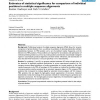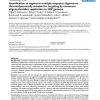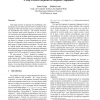26 search results - page 2 / 6 » Automatic detection of anchor points for multiple sequence a... |
BMCBI
2004
13 years 4 months ago
2004
Background: Profile-based analysis of multiple sequence alignments (MSA) allows for accurate comparison of protein families. Here, we address the problems of detecting statistical...
BMCBI
2006
13 years 5 months ago
2006
Background: Multiple sequence alignment is the foundation of many important applications in bioinformatics that aim at detecting functionally important regions, predicting protein...
BMCBI
2004
13 years 4 months ago
2004
Background: Computer programs for the generation of multiple sequence alignments such as "Clustal W" allow detection of regions that are most conserved among many sequen...
RECOMB
2003
Springer
14 years 5 months ago
2003
Springer
We describe a novel method for detecting the domain structure of a protein from sequence information alone. The method is based on analyzing multiple sequence alignments that are ...
CVPR
2000
IEEE
13 years 9 months ago
2000
IEEE
This paper presents an approach for establishing correspondencesin time and in space between two differentvideo sequences of the same dynamic scene, recorded by stationary uncalib...



